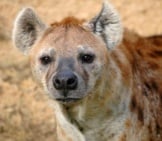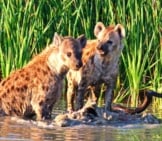Hyenas are known for their famous laugh-like vocalizations. These dog-like predators are actually more closely related to cats, and are a uniquely small member of the carnivore family. There are just four living species of hyenas, and each is slightly different in appearance and behavior. Read on to learn about the hyena.
Description of the Hyena
There are four species of hyenas, and each is built slightly different than another. All living hyenas have similar qualities and a skeletal structure. They have a short torso, and low hindquarters giving their back a hunched appearance.
They have long forelegs and thick necks, and from their heads to their tails, their backs slope noticeably downward. Most species are tan or brown in color, with dark stripes or spots.
Interesting Facts About the Hyena
Hyenas are unique predators that aren’t quite like big cats, but aren’t canines either. Each species has slightly different behavior, but all are incredibly interesting creatures!
- Who Has the Loudest Laugh? – Researchers believe that the pitch and tone of a hyena’s characteristic laugh can indicate their current social status. This can efficiently communicate to the other members if it is a submissive or dominant animal.
- Teamwork – Hyenas are actually incredibly intelligent animals, and they excel at problem solving as a team. Pairs of hyenas in zoos were able to outperform chimpanzees in a social cooperation puzzle, and did so while remaining entirely silent. This indicates that, not only can hyenas communicate with one another effectively, they can communicate efficiently with non-verbal cues.
- Girl Power – Female hyenas are larger, more muscular, and more aggressive than male hyenas. Hyena packs are matriarchal, which means that they are led by a dominant female. Female hyenas actually have three times as much testosterone as the males!
- Life’s Hard for the Boys – Male hyenas live a hard life in a female-dominated society. When males reach sexual maturity they must leave their pack and find another pack to integrate into. The females of other packs will attack males, and it takes lots of fighting and interaction before the male is accepted into the pack. Males are always at the bottom of the pecking order in a hyena pack.
Habitat of the Hyena
Different species of hyenas have slightly different habitat preferences. Aardwolves live in dry, open bushland and plains, and are restricted to areas where termites are plentiful. Spotted hyenas will live in mountainous areas, woodlands, savannas, and even semi-deserts. Brown hyenas live in deserts, semi-deserts, savannas, and will scavenge in urban areas. Finally, striped hyenas live in mountain regions, and scrub woodlands.
Distribution of the Hyena
Different species of hyenas can be found across Africa and into the Middle East. Aardwolves are found in Southern Africa, East Africa, and Northeast Africa. Spotted hyenas are found from Sub-Saharan Africa to northern South Africa, except for rainforest areas. Brown hyenas are found only in southern Africa. Striped hyenas are found in northern Africa, as well as parts of the Middle East.
Diet of the Hyena
Hyenas vary widely in diet, as well as range and habitat. Aardwolves are widely insectivores, and feed largely on termites. Spotted hyenas are primarily predators, and will catch and eat their own prey. Brown and striped hyenas are mainly scavengers, and will eat carcasses in various stages of decomposition. Hyenas eat virtually the entire animal, bones and all, leaving almost nothing behind on a carcass.
Hyena and Human Interaction
Hyenas rarely attack humans, and most instances are attacks of sick or young when outside at night. Many species of these animals are quite timid towards humans, and avoid conflict.
Unfortunately, many species are despised by native people and farmers. Especially with scavenging, hyenas can be wrongly accused of killing livestock when feeding on carcasses. This leads to retaliation killing by farmers and townspeople.
Domestication
No species of hyena has been domesticated in any way.
Does the Hyena Make a Good Pet
Hyenas are wild animals and can be deadly predators. Owning them as a pet is illegal in most places, and can be quite dangerous.
Hyena Care
In zoos, hyenas are kept in packs and provided with lots of enclosure space for exercise and play. They are provided with environmental enrichment in the form of toys, puzzle feeders, whole carcasses, and positive reinforcement training. They are fed a diet of commercial carnivore zoo diet, mice, rats, rabbits, beef heart, fish, chew bones, and a variety of vegetables as treats.
Behavior of the Hyena
Hyenas are social creatures with a female-led hierarchy. They have a dominant female, known as a “matriarch,” who is the largest and most aggressive animal. Some species are quite vocal, and will use a number of laughs, grunts, growls, whoops, and more to communicate with one another. They also have very complex social rituals when interacting with members after a long absence.
Reproduction of the Hyena
When females give birth they seek an isolated den away from the rest of the pack. Gestation period differs based on species. When the cubs are older they will be moved to a communal den with cubs from multiple mothers in the pack. There, they will develop a dominance hierarchy amongst themselves, and the most dominant cubs will eat the most and be most likely to survive.
Cubs will nurse anywhere from one to two years, before becoming fully weaned. Female cubs will stay in the pack, but males leave at around three years old when they reach sexual maturity.











![Red Angus Closeup of a beautiful Red Angus cowPhoto by: U.S. Department of Agriculture [pubic domain]https://creativecommons.org/licenses/by/2.0/](https://animals.net/wp-content/uploads/2020/03/Red-Angus-4-238x178.jpg)


![Red Angus Closeup of a beautiful Red Angus cowPhoto by: U.S. Department of Agriculture [pubic domain]https://creativecommons.org/licenses/by/2.0/](https://animals.net/wp-content/uploads/2020/03/Red-Angus-4-100x75.jpg)

